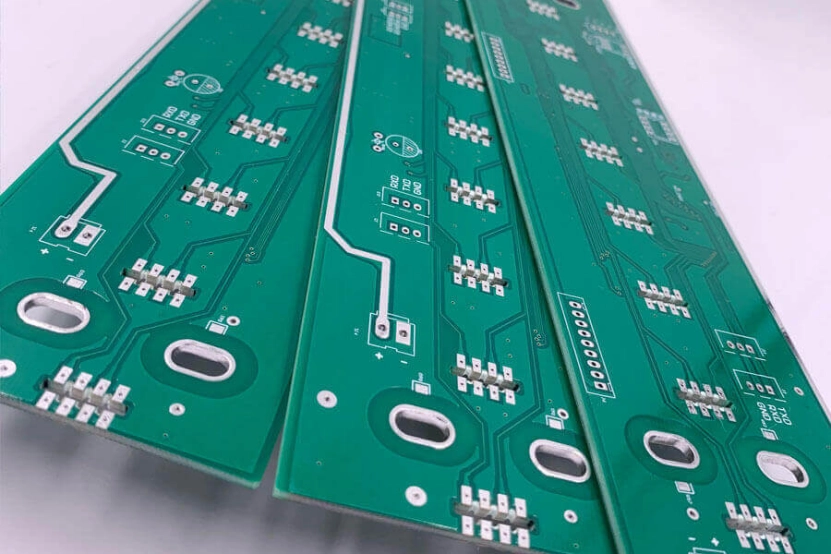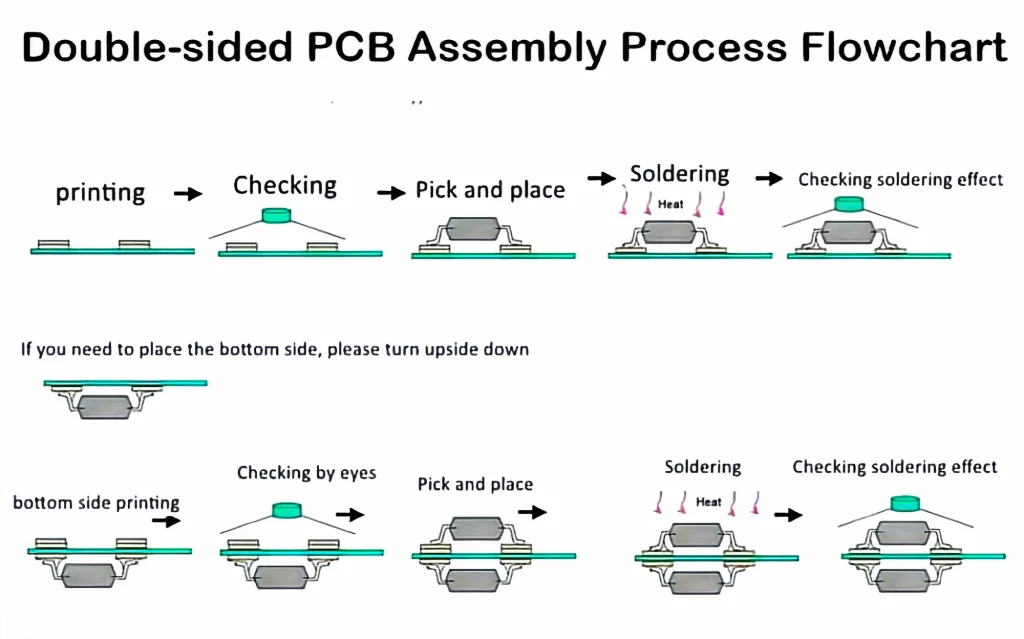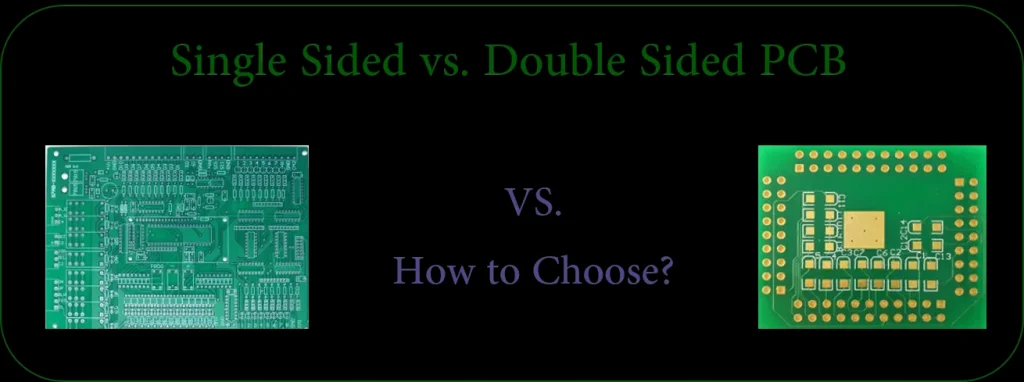Understanding Double Sided PCBs: Basics and Applications
What Is a Double Sided PCB?
A double sided PCB, or double sided printed circuit board, is a variety of circuit panel featuring conductive copper coatings on both surfaces. This layout permits more intricate wiring than a single sided PCB, where parts and pathways are confined to one side. Double sided PCBs provide greater circuit concentration, enhanced linking, and superior efficiency in electronic setups.
In contrast to single sided PCBs, double sided boards grant increased versatility in planning. They can house additional elements. Plus, they enable ties between upper and lower layers via conduits called vias. Consequently, they become a prime pick for tasks needing small yet potent electronic answers.

Where Are Double Sided PCBs Applied?
Double sided PCBs find broad use across diverse fields. In IoT gadgets, they bolster rapid data exchange and effective energy spread. Car systems depend on them for detectors and command units. Meanwhile, consumer gadgets like smartphones and gaming systems employ them for sleek, high-powered designs.
For testing phases, double sided PCBs hold perks over bulk output. Engineers can experiment with trickier circuit patterns before locking into large-scale runs. Their knack for blending through-hole and surface-mount parts on one panel makes them a top choice for swift innovation and trials.
Key Design Elements for Premium Double Sided PCBs
Double Sided PCB Design Top Tips
To craft a stellar double sided PCB, sound design habits are vital. Layout refinement is crucial. It maintains signal clarity and wards off disruption. Parts need smart positioning. This cuts signal fade and boosts energy flow.
Via placement holds a big role in double sided PCB design. Well-set vias foster seamless links between layers. They avoid overcrowding too. Also, heat control methods like sinks and thermal vias dispel extra warmth. This ensures steady operation in high-energy uses.
Material Choice Counts
The caliber of a double sided PCB leans heavily on its materials. Double sided copper clad PCBs are favored for their toughness and superb electrical flow. The copper layer’s depth and grip affect signal relay and lasting dependability.
For high-frequency or hot settings, picking the right base material matters. FR4 suits common tasks well. Yet, niche substances like PTFE fit RF and microwave circuits better. Selecting apt materials ensures the PCB thrives under varied conditions.
The Double Sided PCB Manufacturing Process Unveiled
Step-by-Step Production Flow
The double sided PCB manufacturing process starts with readying design files. After finalizing the blueprint, the panel faces etching, boring, and coating steps. Copper layers get precisely carved to form circuit trails. Drilled openings are then coated to link layers.
Quality checks run throughout. Automated optical inspection (AOI) confirms trails form correctly. Electrical tests verify the panel’s workings. The whole double sided PCB manufacturing process aims to yield trusty, high-performing circuit boards.
Assembly Methods for Exactness

Double sided PCB assembly can use hand or machine methods. Surface-mount technology (SMT) often places parts on both sides with care and accuracy.
Soldering poses a hurdle in double sided PCB assembly. Proper heat handling is key. It prevents solder joint flops. Special reflow soldering tricks ensure firm bonds without harming delicate bits.
5 Traits of an Outstanding Double Sided PCB Prototype
Exact Drilling and Coating
A double sided PCB prototype’s quality hinges on precise drilling and coating. Spot-on hole tolerances secure via links. This lowers the chance of electrical hiccups. Over-etching is a frequent flaw to dodge. It preserves circuit wholeness.
Solid Copper Depth and Bonding
Copper depth shapes PCB efficiency. A top-tier double sided PCB boasts even copper spread. This ensures steady electrical flow and resilience. Firm bonding between copper and the base stops peeling over time.
Cutting-Edge Testing Routines
A dependable PCB faces several test rounds. Automated optical inspection (AOI) spots trail pattern flaws. X-ray scans check hidden solder woes. Functional tests confirm the PCB hits performance goals before use.
Surface Finish Excellence
Surface finish choice sways solderability and rust resistance. Options like HASL (Hot Air Solder Leveling), ENIG (Electroless Nickel Immersion Gold), and immersion silver stand out. A fine PCB picks a finish that boosts part attachment and stretches its life.
Adaptability for Tailoring
A smartly planned PCB should suit varied tasks. High-quality prototypes allow tweaks in size, form, and function. Such adaptability is key for crafting unique electronic goods.
Picking the Ideal Double Sided PCB Manufacturer
Key Queries for Potential Vendors
Choosing a double sided PCB manufacturer calls for weighing vital points. Look at certifications, production skills, and quality benchmarks. Accreditations like ISO and UL signal industry compliance. Prototyping timelines and minimum order sizes should match project needs too.
Why Prototyping Skill Matters
Prototyping know-how can hugely sway the end result. Take a medical gear project as an example. Poor via alignment there led to circuit flops. A savvy manufacturer sidesteps such snags. They use strict quality reviews and precise crafting methods.
Single Sided vs Double Sided PCBs: When to Opt for Which

Cost vs Complexity Balance
Single sided PCBs offer a wallet-friendly fix for basic circuits. Think LED lights or simple power setups. They’re easier to make and assemble. Thus, they suit low-complexity jobs well.
Performance Needs Pushing Dual-Layer Use
For high-octane electronics, double sided PCBs take the lead. They allow complex wiring paths and denser part layouts. Gadgets needing advanced features—like IoT units and speedy processors—gain from their boosted design powers.
FAQs About Double Sided PCBs
How does the double sided PCB assembly process differ from single layer?
Dual-layer boards require precise alignment and via plating to establish interconnections between both sides.
Can I convert a single sided PCB design to double sided?
Yes, but layout adjustments are needed to optimize the use of both layers and improve circuit efficiency.
What’s the main advantage of double sided copper clad PCB boards?
They offer better conductivity and heat dissipation compared to single-layer boards, making them ideal for complex circuits.
How long does prototyping a double sided PCB typically take?
Prototyping time varies, but experienced manufacturers like Silkbridge can deliver within 3–7 days, depending on design complexity.
Silkbridge PCB Customization Service
For projects requiring precision and reliability, Silkbridge offers a complete PCB solution from design to production. With advanced R&D tools and automated SMT assembly, Silkbridge ensures high-quality prototypes for industries such as IoT, automotive, and industrial electronics. Every board undergoes strict testing, including functional validation and environmental stress testing, to guarantee long-term performance.
Ready to take your PCB project to the next level? Contact Silkbridge today for a free consultation at contact@silkbridgeltd.com or reach out via WhatsApp: https://wa.me/8618122838771. Let’s bring your electronic innovations to life!



